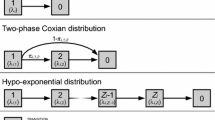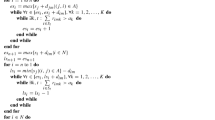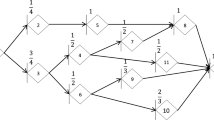Abstract
Project control consists of monitoring a project’s progress at so called control points, finding possible deviations from the baseline schedule and if necessary, making adjustments to the deviated schedule subject to the available control budget, the adjusting strategies and also other technical and environmental possibilities in order to bring the schedule back on the right track. In this study, we adapt for the first time the generalized maximum covering location model to determine the adjusting strategies such that the maximum control coverage is achieved, i.e. under the given constraints, a schedule that is globally as close to the baseline schedule as possible is obtained. Numerical examples are given to illustrate the intricacies of the proposed method and also to demonstrate its applicability.



Similar content being viewed by others
References
Ayutug H, Lawley M, Mckay K, Mohan S, Uzsoy R (2005) Executing production schedules in the face of uncertainties: a review and some future directions. Eur J Oper Res 161(1):86–110
Berman D, Krass D (2002) The generalized maximal covering location problem. Comput Oper Res 29(6):563–581
Berman D, Krass D, Drezner Z (2003) The gradual covering decay location problem on a network. Eur J Oper Res 151:474–480
Blacik B, Beamon BM (2008) Facility location in humanitarian relief. Int J Logist 11:101–121
Deblaere F, Demeulemeester E, Herroelen W (2011) Reactive scheduling in the multi-mode RCPSP. Comput Oper Res 38:63–74
De Falco M, Macchiaroli R (1998) Timing of control activities in project planning. Int J Project Manag 16(1):51–58
Drezner Z, Wesolowsky GO, Drezner T (2004) The gradual covering problem. Naval Res Logist 51(6):841–855
Goldratt E (1997) Critical chain. North River, Great Barrington
Golenko-Ginzburg D, Laslo Z (2001) Timing control points via simulation for production systems under random disturbances. Math Comput Simul 54:451–458
Karasakal O, Karasakal EK (2004) A maximal covering location model in presence of partial coverage. Comput Oper Res 31(9):1515–1526
Kogan K, Raz T, Elitzur R (2002) Optimal control in homogeneous projects: analytically solvable deterministic cases. IIE Trans 34(1):63–75
Kolisch R, Sprecher A (1997) PSPLIB—A project scheduling library. Eur J Oper Res 96:205–216
Kuster J, Jannach D, Friedrich G (2009) Extending the RCPSP for modeling and solving disruption management problems. ApplIntell 31:234–253
Law A, Kelton W (2000) Simulation modelling and analysis, 3rd edn. McGraw-Hill series, New York City
Partovi FY, Burton J (1993) Timing of monitoring and control of CPM projects. IEEE Trans Eng Manag 40(1):68–75
Pich MT, Loch CH, De Meyer A (2002) On uncertainty, ambiguity, and complexity in project management. Manag Sci 48:1008–1023
Raz T, Erel E (2000) Optimal timing of project control points. Eur J Oper Res 127:252–261
Sabeghi N, Tareghian HR, Demeulemeester E, Taheri H (2015) Determining the timing of project control points using a facility location model and simulation. Comput Oper Res 61:69–80
Van de Vonder S, Demeulemeester E, Herroelen W (2007) A classification of predictive-reactive project scheduling procedures. J Sched 10:195–207
Vanhoucke M (2011) On the dynamic use of project performance and schedule risk information during project tracking. Omega 39:416–426
Zhu G, Bard JF, Yu G (2005) Disruption management for resource-constrained project scheduling. J Oper Res Soc 56:365–381
Author information
Authors and Affiliations
Corresponding author
Rights and permissions
About this article
Cite this article
Sabeghi, N., Tareghian, H.R. Using the generalized maximum covering location model to control a project’s progress. Comput Manag Sci 17, 1–21 (2020). https://doi.org/10.1007/s10287-018-0301-5
Received:
Accepted:
Published:
Issue Date:
DOI: https://doi.org/10.1007/s10287-018-0301-5




